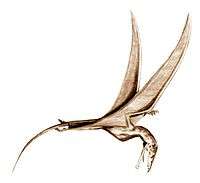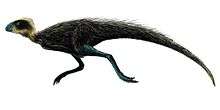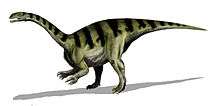Panguraptor
| Panguraptor Temporal range: Early Jurassic, 201–196 Ma | |
|---|---|
| Scientific classification | |
| Kingdom: | Animalia |
| Phylum: | Chordata |
| Class: | Reptilia |
| Clade: | Dinosauria |
| Order: | Saurischia |
| Suborder: | Theropoda |
| Family: | †Coelophysidae |
| Subfamily: | †Coelophysinae |
| Genus: | †Panguraptor You et al., 2014 |
| Type species | |
| Panguraptor lufengensis You et al., 2014 | |
Panguraptor ("Pangu [a Chinese god] plunderer") is a genus of theropod dinosaur known from fossils discovered in Lower Jurassic rocks of southern China.
Panguraptor is known from the partial articulated skeleton of a subadult individual, including the skull, lower jaws, presacral vertebrae, first sacral vertebra, parts of the pectoral girdle and pelvic girdle, and partial limbs. This specimen was recovered on 12 October 2007 from the Lufeng Formation of Yunnan, which is noted for sauropodomorph fossils. It was described in 2014 by You Hai-Lu and colleagues. The type and only known species is Panguraptor lufengensis. The generic name refers to the deity Pangu but also to the supercontinent Pangaea for which in a geological context the same characters are used: 盘古. Raptor means "seizer", "robber" in Latin. The specific name is a reference to the Lufeng Formation.[1]
You et. al. performed a phylogenetic analysis and found Panguraptor to be a coelophysid coelophysoid, closer to Coelophysis bauri than "Megapnosaurus" kayentakatae. Per this analysis, Panguraptor would be the first coelophysoid known from Asia. It is also the second definite theropod genus known from the Lufeng Formation, after Sinosaurus.[1]
References
- 1 2 Hai-Lu You, Yoichi Azuma, Tao Wang, Ya-Ming Wang and Zhi-Ming Dong (2014). "The first well-preserved coelophysoid theropod dinosaur from Asia". Zootaxa. 3873 (3): 233–249. doi:10.11646/zootaxa.3873.3.3.



